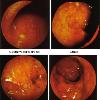

Endoscopic image of ulcerative colitis showing loss of vascular pattern of the sigmoid colon, granularity and some friability of the mucosa. -- Samir धर्म 0209, 3 October 2006 (UTC) Tags: Ulcerative Colitis View |
Crohn s Disease In Crohn s Disease previously known as regional ileitis Tags: Ulcerative Colitis View |
Ulcerative colitis Ulcerative colitis causes inflammation and sores ulcers in the lining of the large intestine Ulcers form where the inflammation has killed the cells lining the colon the ulcers bleed Tags: Ulcerative Colitis View |
|||||||||
Ulcerative colitis (Colitis ulcerosa, UC) is a form of inflammatory bowel disease (IBD). Ulcerative colitis is a form of colitis, a disease of the intestine, specifically the large intestine or colon (colon (anatomy)), that includes characteristic ulcers (Peptic ulcer), or open sores, in the colon. The main symptom of active disease is usually constant diarrhea mixed with blood, of gradual onset. Because of the name, IBD is often confused with irritable bowel syndrome ("IBS"), a troublesome, but much less serious, condition. Ulcerative colitis has similarities to Crohns disease, another form of IBD. Ulcerative colitis is an intermittent disease, with periods of exacerbated symptoms, and periods that are relatively symptom-free. Although the symptoms of ulcerative colitis can sometimes diminish on their own, the disease usually requires treatment to go into remission (Remission (medicine)).
Ulcerative colitis occurs in 35-100 people for every 100,000 in the United States, or less than 0.1% of the population. The disease is more prevalent in northern countries of the world, as well as in northern areas of individual countries or other regions. Although ulcerative colitis has no known cause, there is a presumed genetic (genetics) component to susceptibility. The disease may be triggered in a susceptible person by environmental factors. Although dietary modification may reduce the discomfort of a person with the disease, ulcerative colitis is not thought to be caused by dietary factors. Although ulcerative colitis is treated as though it were an autoimmune disease (autoimmunity), there is no consensus that it is such. Treatment is with anti-inflammatory drugs, immunosuppression, and biological therapy (Biological therapy for inflammatory bowel disease) targeting specific components of the immune response. Colectomy (partial or total removal of the large bowel through surgery) is occasionally necessary, and is considered to be a cure for the disease.
Icd10: ICD10K51k50
Icd9: ICD9556
Diseasesdb: 13495
Omim: 191390
Emedicinesubj: med
Emedicinetopic: 2336
Medlineplus: 000250
Meshid: D003093



